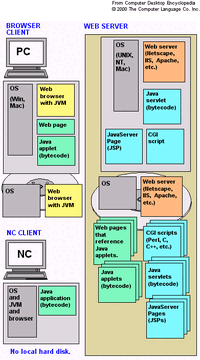Introduction[]

This is how a Java Virtual Machine works.
A Java Virtual Machine (JVM) is a set of computer software programs and data structures that use a virtual machine model for the execution of other computer programs and scripts. The model used by a JVM accepts a form of computer intermediate language commonly referred to as Java bytecode. This language conceptually represents the instruction set of a stack-oriented, capability architecture. As of 2006, there are an estimated four billion JVM-enabled devices worldwide.
Java Virtual Machines operate on Java bytecode, which is normally (but not necessarily) generated from Java source code; a JVM can also be used to implement programming languages other than Java. For example, Ada source code can be compiled to Java bytecode, which may then be executed by a JVM. JVMs can also be released by other companies besides Sun (the developer of Java) — JVMs using the "Java" trademark may be developed by other companies as long as they adhere to the JVM specification published by Sun (and related contractual obligations).
The JVM is a crucial component of the Java Platform. Because JVMs are available for many hardware and software platforms, Java can be both middleware and a platform in its own right — hence the trademark write once, run anywhere. The use of the same bytecode for all platforms allows Java to be described as "compile once, run anywhere", as opposed to "write once, compile anywhere", which describes cross-platform compiled languages. The JVM also enables such unique features as Automated Exception Handling that provides 'root-cause' debugging information for every software error (exception) independent of the source code.
The JVM is distributed along with a set of standard class libraries that implement the Java API (Application Programming Interface). An application programming interface is what a computer system, library or application provides in order to allow data exchange between them. As the Web API is the Web version of this interface, the JVM and API have to be consistent with each other. [1]
Execution enviroment[]
Programs intended to run on a JVM must be compiled into a standardized portable binary format, which typically comes in the form of .class files. A program may consist of many classes in different files. For easier distribution of large programs, multiple class files may be packaged together in a .jar file (short for Java archive).
The JVM runtime executes .class or .jar files, emulating the JVM instruction set by interpreting it, or using a just-in-time compiler (JIT) such as Sun's HotSpot. JIT compiling, not interpreting, is used in most JVMs today to achieve greater speed. Ahead-of-time compilers that enable the developer to precompile class files into native code for a particular platform also exist.
Like most virtual machines, the Java Virtual Machine has a stack-based architecture akin to a microcontroller/microprocessor.
The JVM, which is the instance of the JRE (Java Runtime Environment), comes into action when a Java program is executed. When execution is complete, this instance is garbage-collected. JIT is the part of the JVM that is used to speed up the execution time. JIT compiles parts of the byte code that have similar functionality at the same time, and hence reduces the amount of time needed for compilation.
Bytecode verifier[]
A basic philosophy of Java is that it is inherently "safe" from the standpoint that no user program can "crash" the host machine or otherwise interfere inappropriately with other operations on the host machine, and that it is possible to protect certain functions and data structures belonging to "trusted" code from access or corruption by "untrusted" code executing within the same JVM. Furthermore, common programmer errors that often lead to data corruption or unpredictable behavior such as accessing off the end of an array or using an uninitialized pointer are not allowed to occur. Several features of Java combine to provide this safety, including the class model, the garbage-collected heap, and the verifier.
The JVM verifies all bytecode before it is executed. This verification consists primarily of three types of checks:
- Branches are always to valid locations
- Data is always initialized and references are always type-safe
- Access to "private" or "package private" data and methods is rigidly controlled.
The first two of these checks take place primarily during the "verification" step that occurs when a class is loaded and made eligible for use. The third is primarily performed dynamically, when data items or methods of a class are first accessed by another class.
The verifier permits only some bytecode sequences in valid programs, e.g. a jump (branch) instruction can only target an instruction within the same function or method. Because of this, the fact that JVM is a stack architecture does not imply a speed penalty for emulation on register-based architectures when using a JIT compiler. In the face of the code-verified JVM architecture, it makes no difference to a JIT compiler whether it gets named imaginary registers or imaginary stack positions that need to be allocated to the target architecture's registers. In fact, code verification makes the JVM different from a classic stack architecture whose efficient emulation with a JIT compiler is more complicated and typically carried out by a slower interpreter.
Code verification also ensures that arbitrary bit patterns cannot get used as an address. Memory protection is achieved without the need for a Memory management unit (MMU). Thus, JVM is an efficient way of getting memory protection on simple architectures that lack an MMU. This is analogous to managed code in Microsoft's .NET Common Language Runtime, and conceptually similar to capability architectures such as the Plessey 250, and IBM System/38.
See Also[]
References[]
1. An Introduction to Web APIs
Links[]

|
This page uses content from Wikipedia. The original article was at Java Virtual Machine. The list of authors can be seen in the page history. As with Java Wiki, the text of Wikipedia is available under the GNU Free Documentation License. |
JAVA RULES!!!